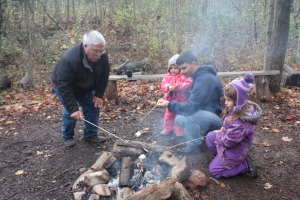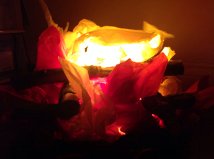Weekly Challenge # 18 – Why I Believe the Perfect 21st Century Learning Tool is an Old Fashion Campfire
For millennia, the campfire has been a place for folks to gather. The crackle of the fire almost instinctively tells those gathered around it is time to listen, to focus and be ready to learn. Storytellers would use the escalation and then the dying of the fire in their story telling – arranging the climax of the story or songs to synchronize with the zenith of the fire’s growth before leading into quieter more subdued discussions as the flames turned to embers.
This is not a rant against technology, in fact my own school board has taken on a very progressive BYOD (Bring Your Own Device) stance which I fully support. While as a Boy Scout myself I remember being told to leave my flashlight in the tent while heading to the campfire I have no concerns with any device that is considered by the teacher to be the right tool at the right time in the right place, even around the campfire.
However, from a 21st Century Learning point of view I believe that the campfire is the perfect tool. To some it may seem primitive and almost a backwards move but let me explain.
I believe we are past the point of desks in rows and all the students staring at the “Sage on the stage”. Most of us now see benefit in more conversation, dialogue and discussion in our learning styles. This is why so many educators have desks no longer in rows but in small pods or semi-circles.
We live in a global village. We eat different foods, we have different faiths, we speak different languages but everyone worldwide has the Instinct of the value of a campfire. Perhaps due to urban jungles or other reasons your students have not experienced a real campfire – but I would hazard a guess that their first experience will create at least some of the same behaviours no matter what their background.
The campfire concept allows for a focal point. And learners today are extremely capable of multi-tasking. They can listen just as attentively as they cook a marshmallow as while holding a tablet. As you light the fire – it can represent a beginning to the conversation. As the embers begin to glow it allows for closure and so an end to the conversation. It allows for everyone to face each other, to share, to discuss, to comment. It allows time for honest debriefing. And as Stephen King said in The Green Mile, “Sometimes the embers are better than the campfire.”
From a restorative justice point of view, it is much easier for students to be open and communicate when they are staring into the mesmerizing flames of the fire rather than at each other.
Now I recognize we cannot all have a real campfire in our classroom or around our schoolyard. When you do manage a field trip to your local nature centre or on an overnight camp hopefully you can experience the real thing but there are many great examples of indoor campfires which can be used. Most Scout or Guiding troops have a plug-in model for those days when they can’t go outside due to weather or fire ban restrictions. They can be made from craft materials or perhaps real wood and a small light bulb that glows. Mrs. Webster, an Illinois based teacher, has a wonderful blog post on how she used not only an indoor campfire in the classroom but an entire campsite. I have even seen models that make the crackling sound or have a small fan unit to blow the “flames” to make it look more realistic. The “lighting” of the indoor campfire can still be a magical episode with the right ceremony or atmosphere.
Here is simple one I made in about 15 minutes (once I had the logs and tissue paper) and I’m more than happy to lend it to schools in my own Board to give it a try.
Many teachers of younger students have a corner set up with a rocking chair and rug which is used to tell stories. But some stories could easily be told around an indoor campfire with the lights down low. The atmosphere created will add to the storytelling dramatically. In fact, perhaps every school library should have a campfire.
It does not need to be all Native legends or ghostly tales either. Imagine if your students’ speeches were not done on the traditional stage in front of their classmates, but in the campfire circle where the best stories are told and where the best listeners are often enthralled. Would the speaker/storyteller feel more at ease?
Even for our older students, I think if I taught in a high school I would enjoy greeting my students the first day around a campfire to set expectations and norms. Along the same lines, I’d love to finish the semester with my last lab being a campfire as well to discuss what was learned as well as preparation for the final exams.
I’d even go so far as to say everything above makes a great case for a faculty meeting around a campfire as well.
Having a campfire available to your class can grant permission for your students to exercise their creativity, collaborate with each other and feeds their desire for a voice in their education, values and beliefs. Sounds like a perfect 21st Century Learner Tool to me.
Give it a try. Then let me know your thoughts?


Excellent thoughts, Ranger Ridley. You could say that the campfire is another “tool” that teachers and students have available to them for students to demonstrate their learning. On a similar theme, I will be reading “Dot.” by Randi Zuckerberg to my school on Tuesday morning at our weekly assembly. This picture book emphasizes the importance of staying in touch with nature and finding a balance of time for devices and nature.
Maybe I will set the gym up in a campfire style. Could I borrow your “indoor campfire”? Thanks for what you do.
Thank you for sharing Rob. What a wonderful vision! I think it pulls on both our love for story, community and connection which crosses all cultural boundaries.
I really like this too… I use the “magic spots” in class to get focus and talk about nature, but I think the campfire is a strong tool. Something that we all kind of get lost in. Great stuff.
Some thoughts for ya:
1) The flavours of smoked things have never been more popular than now (bbq, bacon, etc). Perhaps that’s part of the primitive tug back to when humans cooked over open flames all the times. So no, the image of a campfire doesn’t seem out of step with the 21st C at all…
2) Rogers still has the campfire channel. Some people must watch it.
3) My little ones are crazy for flashlights and candles. Drawn to the light and flame?
4) Restorative campfire circles…something perfect about the symbolism of a circle.
Thanks for your wise words.